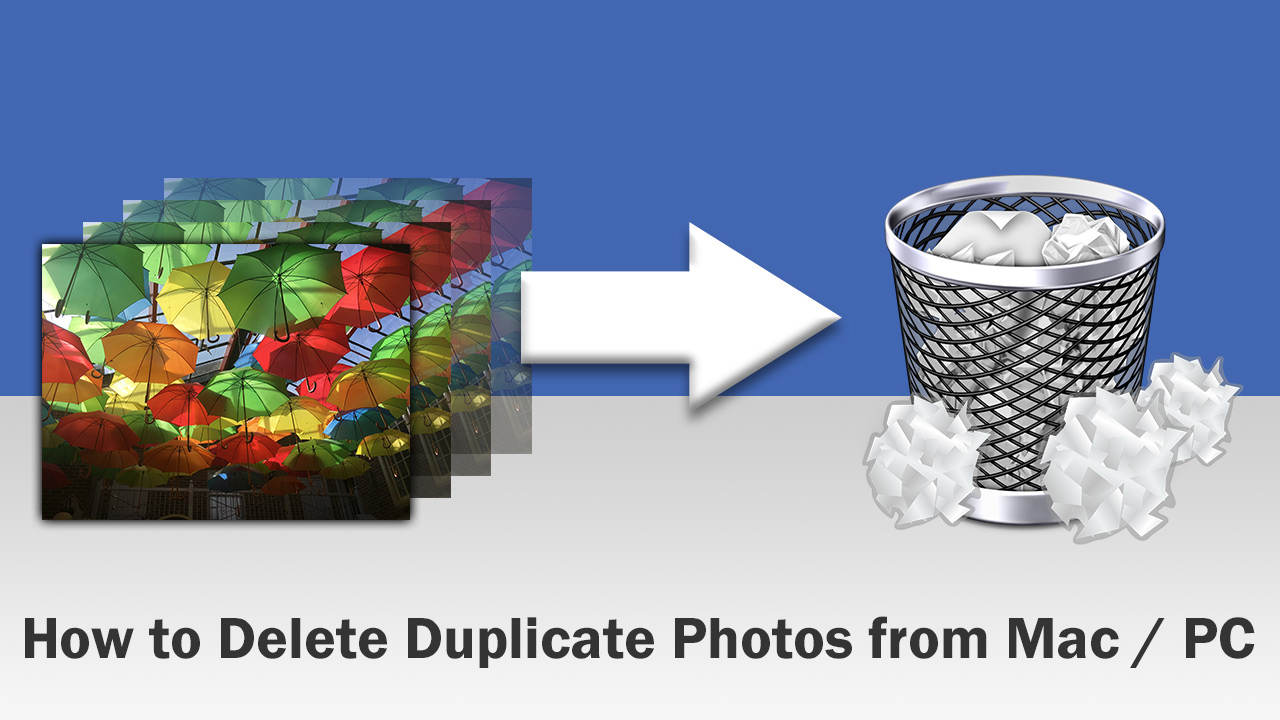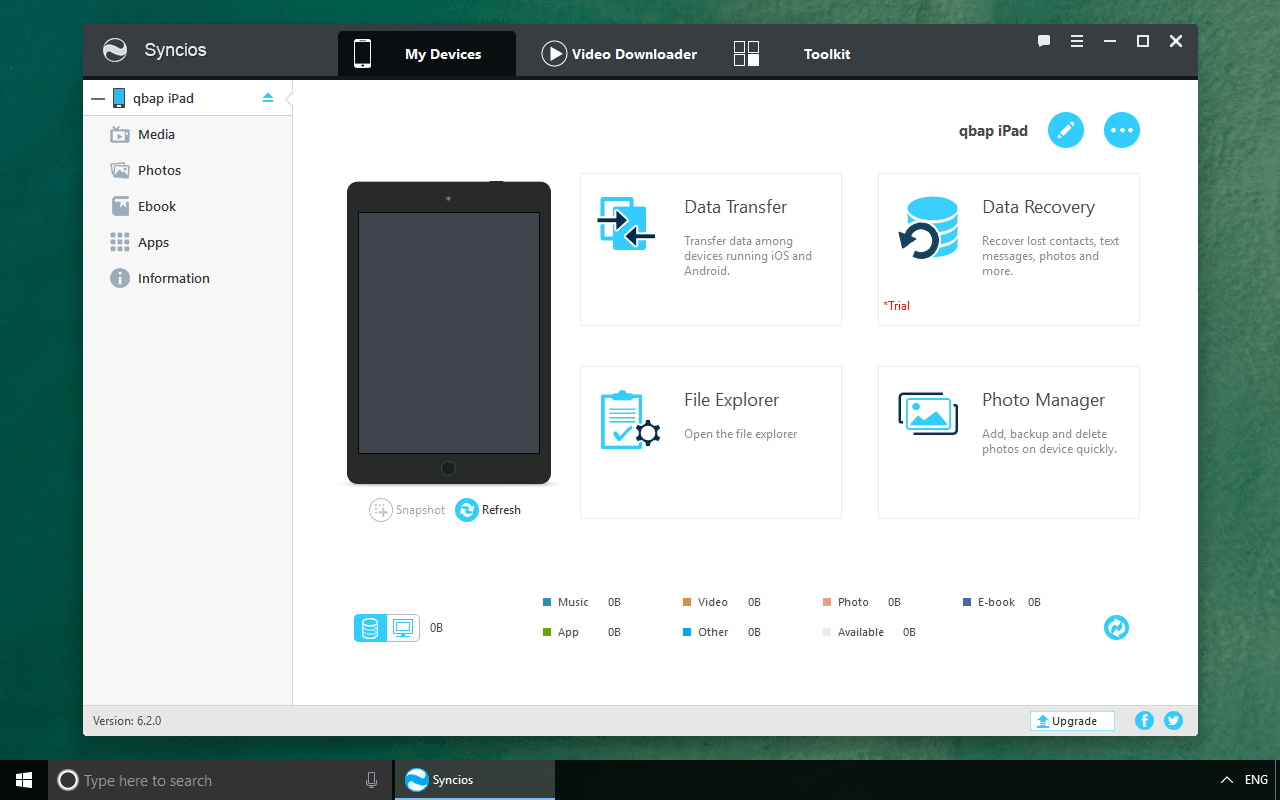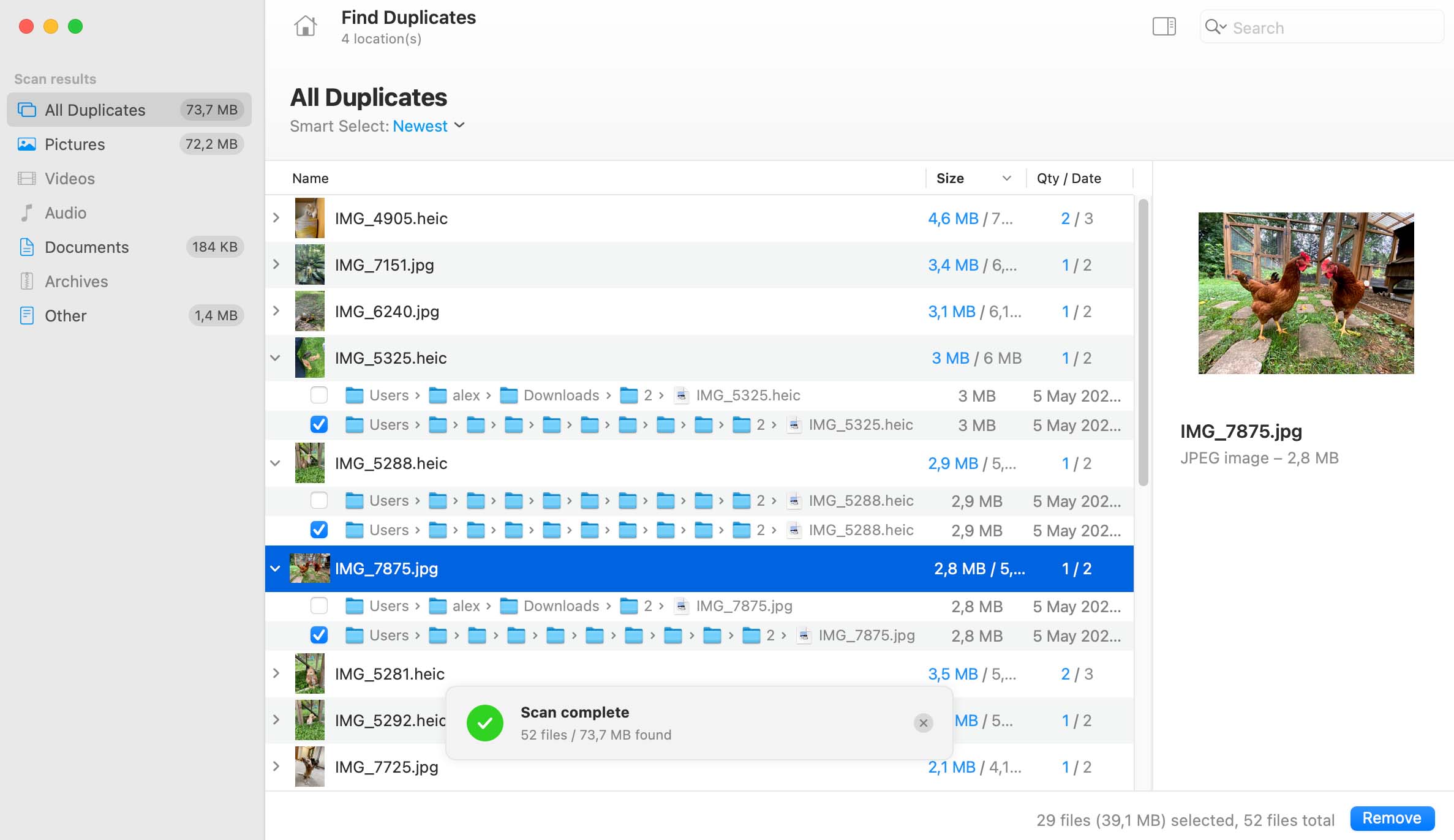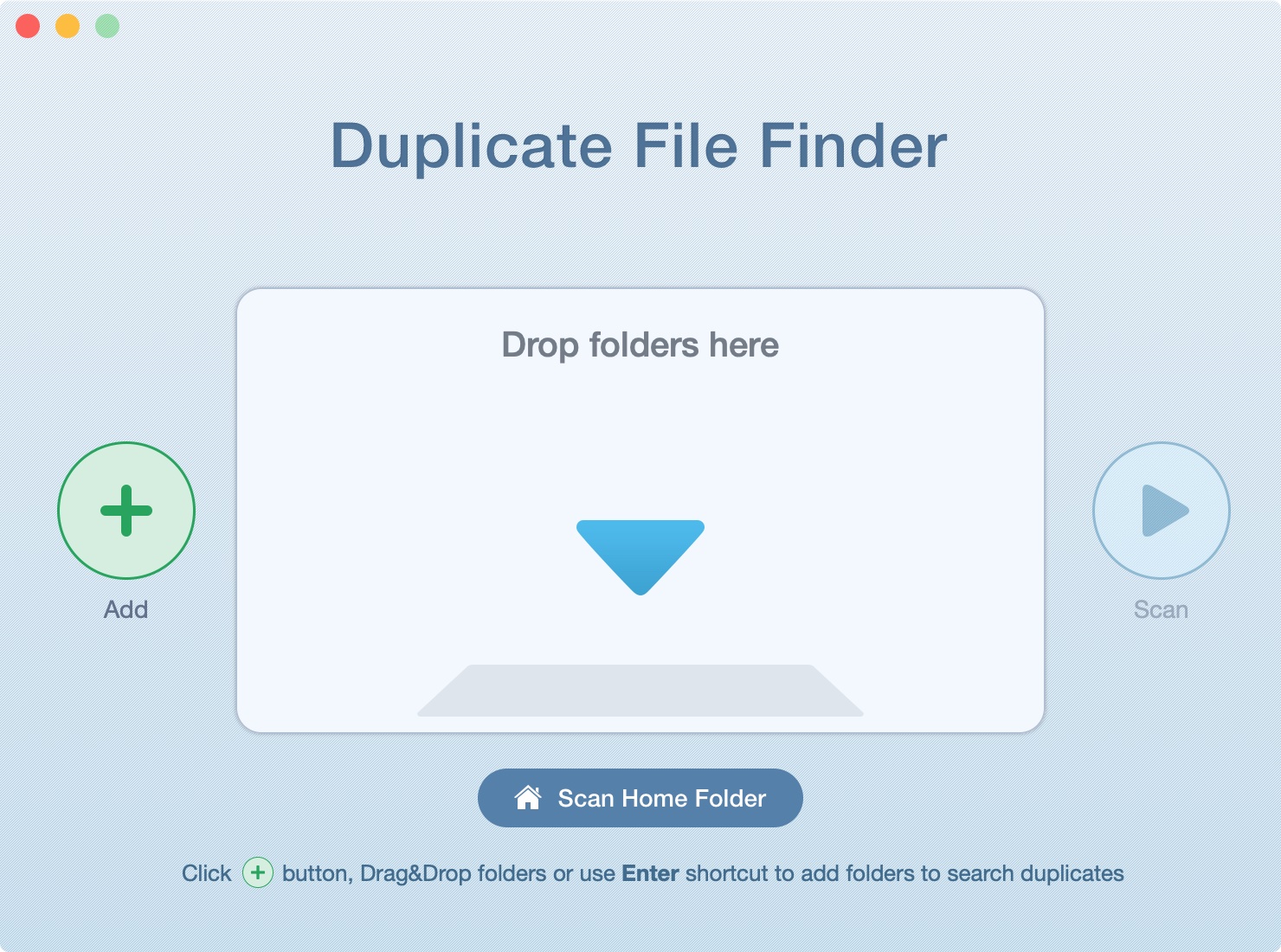How To Delete Duplicate Files On Mac For Free
If you no longer need any copies of the file, you can recover all of the storage space by deleting both the duplicate and the original file. If you're using a pro app and Optimize Mac Storage, learn how to make sure that your projects are always on your Mac and able to access their files. DupeGuru (Free) dupeGuru is an open source duplicate file finder Mac, Windows, and Linux users can download, install, and use completely free of charge. Thanks to its quick fuzzy matching algorithm, dupeGuru is highly efficient and capable of discovering hundreds of duplicates in a very short amount of time.
- How To Delete Duplicate Files On Mac For Free Without
- How To Delete Duplicate Files On Mac For Free Online
- How To Delete Duplicate Files On Mac For Free
- How To Delete Duplicate Files On Mac For Free Windows 10
The Optimized Storage features of your Mac help you save storage space by storing your content in iCloud and making it available on demand:
- When storage space is needed, files, photos, movies, email attachments, and other files that you seldom use are stored in iCloud automatically.
- Each file stays right where you last saved it, and downloads when you open it.
- Files that you’ve used recently remain on your Mac, along with optimized versions of your photos.

If you haven't yet upgraded to macOS Sierra or later, learn about other ways to free up storage space.
Find out how much storage is available on your Mac
Choose Apple menu > About This Mac, then click Storage. Each segment of the bar is an estimate of the storage space used by a category of files. Move your pointer over each segment for more detail.
Click the Manage button to open the Storage Management window, pictured below.
Manage storage on your Mac
The Storage Management window offers recommendations for optimizing your storage. If some recommendations are already turned on, you will see fewer recommendations.
Store in iCloud
Click the Store in iCloud button, then choose from these options:
- Desktop and Documents. Store all files from these two locations in iCloud Drive. When storage space is needed, only the files you recently opened are kept on your Mac, so that you can easily work offline. Files stored only in iCloud show a download icon , which you can double-click to download the original file. Learn more about this feature.
- Photos. Store all original, full-resolution photos and videos in iCloud Photos. When storage space is needed, only space-saving (optimized) versions of photos are kept on your Mac. To download the original photo or video, just open it.
- Messages. Store all messages and attachments in iCloud. When storage space is needed, only the messages and attachments you recently opened are kept on your Mac. Learn more about Messages in iCloud.
Storing files in iCloud uses the storage space in your iCloud storage plan. If you reach or exceed your iCloud storage limit, you can either buy more iCloud storage or make more iCloud storage available. iCloud storage starts at 50GB for $0.99 (USD) a month, and you can purchase additional storage directly from your Apple device. Learn more about prices in your region.
Optimize Storage
Click the Optimize button to save space by automatically removing watched movies and TV shows. When storage space is needed, movies or TV shows that you purchased from Apple and already watched are removed from your Mac. Click the download icon next to a movie or TV show to download it again.
Your Mac will also save space by keeping only recent email attachments on this Mac when storage space is needed. You can manually download any attachments at any time by opening the email or attachment, or saving the attachment to your Mac.
Optimizing storage for movies, TV shows, and email attachments doesn't require iCloud storage space.
Empty Trash Automatically
Empty Trash Automatically permanently deletes files that have been in the Trash for more than 30 days.

Reduce Clutter
Reduce Clutter helps you identify large files and files you might no longer need. Click the Review Files button, then choose any of the file categories in the sidebar, such as Applications, Documents, Music Creation, or Trash.
You can delete the files in some categories directly from this window. Other categories show the total storage space used by the files in each app. You can then open the app and decide whether to delete files from within it.
Learn how to redownload apps, music, movies, TV shows, and books.
Where to find the settings for each feature
The button for each recommendation in the Storage Management window affects one or more settings in other apps. You can also control those settings directly within each app.
- If you're using macOS Catalina or later, choose Apple menu > System Preferences, click Apple ID, then select iCloud in the sidebar: Store in iCloud turns on the Optimize Mac Storage setting on the right. To turn off iCloud Drive entirely, deselect iCloud Drive.
- If you're using macOS Mojave or earlier, choose Apple menu > System Preferences, click iCloud, then click Options next to iCloud Drive. Store in iCloud turns on the Desktop & Documents Folders and Optimize Mac Storage settings.
- In Photos, choose Photos > Preferences, then click iCloud. Store in iCloud selects iCloud Photos and Optimize Mac Storage.
- In Messages, choose Messages > Preferences, then click iMessage. Store in iCloud selects Enable Messages in iCloud.
- If you're using macOS Catalina or later, open the Apple TV app, choose TV > Preferences from the menu bar, then click Files. Optimize Storage selects “Automatically delete watched movies and TV shows.”
- In you're using macOS Mojave or earlier, open iTunes, choose iTunes > Preferences from the menu bar, then click Advanced. Optimize Storage selects “Automatically delete watched movies and TV shows.”
- In Mail, choose Mail > Preferences from the menu bar, then click Accounts. In the Account Information section on the right, Optimize Storage sets the Download Attachments menu to either Recent or None.
Empty Trash Automatically: From the Finder, choose Finder > Preferences, then click Advanced. Empty Trash Automatically selects “Remove items from the Trash after 30 days.”
Other ways that macOS helps automatically save space
With macOS Sierra or later, your Mac automatically takes these additional steps to save storage space:
How To Delete Duplicate Files On Mac For Free Without
- Detects duplicate downloads in Safari, keeping only the most recent version of the download
- Reminds you to delete used app installers
- Removes old fonts, languages, and dictionaries that aren't being used
- Clears caches, logs, and other unnecessary data when storage space is needed
How to free up storage space manually
Even without using the Optimized Storage features described in this article, you can take other steps to make more storage space available:
- Music, movies, and other media can use a lot of storage space. Learn how to delete music, movies, and TV shows from your device.
- Delete other files that you no longer need by moving them to the Trash, then emptying the Trash. The Downloads folder is good place to look for files that you might no longer need.
- Move files to an external storage device.
- Compress files.
- Delete unneeded email: In the Mail app, choose Mailbox > Erase Junk Mail. If you no longer need the email in your Trash mailbox, choose Mailbox > Erase Deleted Items.
Learn more
- The Storage pane of About This Mac is the best way to determine the amount of storage space available on your Mac. Disk Utility and other apps might show storage categories such as Not Mounted, VM, Recovery, Other Volumes, Other, Free, or Purgeable. Don't rely on these categories to understand how to free up storage space or how much storage space is available for your data.
- When you duplicate a file on an APFS-formatted volume, that file doesn't use additional storage space on the volume. Deleting a duplicate file frees up only the space required by any data you might have added to the duplicate. If you no longer need any copies of the file, you can recover all of the storage space by deleting both the duplicate and the original file.
- If you're using a pro app and Optimize Mac Storage, learn how to make sure that your projects are always on your Mac and able to access their files.
While most Macs have a decent amount of storage space, it’s not unlimited. So, you have to be smart about what you’re saving. And duplicate files are only a waste of space. But finding and deleting those duplicates requires an extreme amount of patience or an app that will find those duplicates for you.
Keep reading and you’ll learn how to clean your Mac of duplicates both with an app and manually. The methods you’ll be reading about include:
- Duplicate file finder app
- Terminal commands
- Smart folders in Finder
Why is my Mac duplicating files?
There are a ton of reasons your Mac could be loaded with duplicate files. Maybe you’ve imported the same photos from your camera multiple times and didn’t realize it. Or you couldn’t find a file you were sent, so you just re-downloaded it. Duplicates are a normal part of using a computer, which is why you should regularly check and clean your Mac for duplicate files.

How to find duplicate files on Mac
Over time your Mac is going to fill up and run out of storage space. And most likely, duplicates that take up a good amount of your valuable space. Sure, you can try to sort through all of your files, searching for those duplicate documents, photos, and music files. But if your hard drive is already full, that means you’ve got a lot of files to sift through. And it’s going to take you a very long time to go through them one-by-one.
1. Delete duplicate files with Gemini 2
There are a ton of duplicate finder tools out there, but we’ll take Gemini 2 as an example, because we’re 100% sure it works. Once you have Gemini 2 downloaded and installed, just follow these steps to scan all of the folders on your Mac:
- Download, install and open Gemini 2.
- Click the + > Choose Customer Folder...
- Then, select your hard drive. Unless you’ve renamed it, it’s called Macintosh HD.
- Click Scan for Duplicates.
When the scan is over (which doesn’t take long), you get two options: Review Results and Smart Cleanup.
Smart Cleanup means you’ll automatically delete all of the files Gemini 2 thinks are duplicates, leaving the originals in place. While Review Results will allow you to do exactly what it suggests. You’ll be able to see all of your files and select which ones you want to delete.
That’s pretty much all there is to it. Gemini 2 will delete duplicate files in your Photos, Downloads, Mail Downloads, iTunes, and all the other locations on your disk. It’s by far, the easiest and fastest way to find and delete all of the duplicates on your Mac.
2. Find duplicate files with a Terminal
Before you jump into Terminal headfirst, you should only do it if you're comfortable and know your way around Terminal. It’s a powerful tool that can mess up a lot if you don’t know what you’re doing. We’ve tested the steps below and nothing bad happened, but you should still be careful and double check everything you type into the command line.
So, here’s how you search for duplicate files with Terminal:
- In Finder, go to Applications > Utilities > Terminal to open it.
- Navigate to the folder you want to scan with the cd command. For example, if you want to scan Downloads, type in cd ~/Downloads and hit Enter.
- Copy and paste this command:
find . -size 20 ! -type d -exec cksum {} ; | sort | tee /tmp/f.tmp | cut -f 1,2 -d ‘ ‘ | uniq -d | grep -hif – /tmp/f.tmp > duplicates.txt and hit Enter.
This will create a text file in the folder you’ve specified, with a list of your duplicates inside. But, there are two things you should keep in mind:
How To Delete Duplicate Files On Mac For Free Online
- This terminal command overlooks a lot of duplicates.
- You’ll still need to locate those duplicate files and sift through them to separate the copies from the originals.
So, this command is more like a crystal ball: it gives you hints, but you still have to go and do the sorting and deleting manually. Which brings us to another option, that will do a little more of the work for you.
Sometimes files won’t be flagged as duplicates because they have slightly different file names. But every file has what’s called an md5 hash, which is a unique identifier that stays with the file. So even if you move or rename a file, it’s md5 hash will remain the same.
Similar to the Terminal command above, you can generate a list that shows the md5 tag to verify all of the duplicates in a particular folder. Follow the steps below to create that list.
- Open Terminal from the Utilities folder.
- For this example, we’ll scan the Documents folder. Type into the Terminal window: ~/Documents.
- Copy and paste this code:
find ./ -type f -exec md5 {} ; | awk -F '=' '{print $2 't' $1}' | sort | tee duplicates.txtand then hit enter. - Then, open a Finder window and navigate to your Documents folder.
- Open the Documents.txt file.
This generates a list of all of the files in the folder you’ve specified, but you’ll at least be able to see the md5 tags to know which files are copies of each other.
3. Find duplicate files on Mac using Smart folders
The truth is duplicate files can live anywhere on your hard drive, which makes finding them that much trickier. But thanks to a feature in Finder called Smart Folders, you can narrow your search down based on specific criteria. Say you want to search all of the documents on your Mac, then you’d follow these steps:
- In a new Finder window, click File > New Smart Folder and make sure This Mac is selected.
- In the top-right corner, click +.
- From the first drop-down menu, select Kind and in the second drop-down, choose Documents. Then, click Save.
- A pop-up window will come up, letting you name the folder and choose where to save the Smart Folder.
- From there, you can see all of your documents. Click to order the files by either name, size, or date created to help you quickly spot duplicates.
- Select the files you want to delete.
- Right-click (or hold down Command and click) and then click Move to Trash.
How to locate duplicate files using Smart Folders
While using Smart Folders is a lot faster than hunting through your entire hard drive for duplicate files, it still requires a bit of patience. Manually going through each of your files one-by-one can take some time, even after you’ve narrowed them down.
4. Find duplicate pictures in your Photos library
You move a bunch of new photos onto your Mac, import them into Photos, and start sorting them out. What you probably don’t know is that all of those pics now exist in two copies: one in the initial folder (say, Documents), and one in Home > Pictures > Photos Library. So, the best thing to do is to use the import features in either iPhoto or Photos.
Now, how do you find these duplicate photos and get rid of them? Depends on how much you rely on Photos for viewing and organizing your pics. If you never liked the app anyway and have backups of all pics in other folders, just go ahead and empty the Photos library. Remember two things here, though:
- Delete your pics in Photos only when you’re 100% sure you have copies of them in another folder.
- When you delete duplicate files in Photos, they are not removed — just moved to a Recently Deleted folder. Meaning they’re still taking up storage space. So, don’t forget to empty your Recently Deleted folder too.
Find similar photos in Photos
If you are using Photos to store and organize your pictures, keep in mind that it only displays files stored in Home > Pictures > Photos Library. So, if your pics are duplicated, you’ll have to remove the copies that are stored elsewhere. Here’s how you can find them:
- In Photos, open the Photos tab to see all your pics sorted by date.
- In Finder, open All My Files to view all your pics in bulk, not in a dozen individual folders.
- Sort the files by Date Created, so that your pics in Finder are listed more or less in the order they’re listed in Photos.
- Now comes the tedious part. Take a group of pics in Photos, created within the same day — say, April 17, 2015. Go to Finder, spot the 2015 section, and find that identical group of pics (they will be located together, so you just need to look carefully).
Repeat step 4 for all the pictures you have in your Photos library. That way, you’ll find and remove the duplicate photos that are stored in other locations, and keep only the pics in your Photos library.
You’ll quickly see how long it will take you to find and delete your photos manually. But if you used an app like Gemini 2, it can do most of the heavy lifting for you. Plus, you’re able to review all of the duplicates Gemini finds or just delete them all with one click. The best part is you can download Gemini 2 for free and see how it works.
5. How to find duplicates in Mail Downloads
How To Delete Duplicate Files On Mac For Free
Here’s a common scenario: a colleague emails you a document, and you open the attachment in Mail to take a look at it. You’re going to need this file, so you download it onto your Mac for safe keeping. No duplicates, nothing to talk about here. Right?
Not exactly. See, the Mail app has quietly downloaded this attachment the moment you opened it, and stashed it in its very own downloads folder. So, now you have two copies of the same file on your Mac.

The Mail Downloads folder is not particularly easy to find. You really have to know where to look to get to it. Follow these steps to access it:
- Open Finder.
- In the Menu bar, click Go > Go to Folder…
- Type this address:
~/Library/Containers/com.apple.mail/Data/Library/Mail Downloads and hit Go.
This will open a new Finder window where all of your Mail attachments live. The good news here is that there’s nothing to compare or sort. These files are automatically downloaded to make it faster to open the next time you need them. But all the attachments still live on your email server and can be re-downloaded at any time. Meaning, if there’s nothing you would miss, you could empty this entire folder.
How to find duplicate files in specific folders
You can also use Smart Folders to look for duplicates within specific folders. This is particularly helpful in instances when you have multiple folders in a folder. To set up a Smart Folder that searches a specific folder:

- Go to the folder you want to search in Finder and click File > New Smart Folder.
- In the Search bar at the top of the window, click the folder name.
- Click + in the top-right corner.
- Set your other search criteria and click Save.
- Then, name your Smart Folder and choose where to save it.
- Organize your files by name, size, or date created to help you see the duplicates.
- Select the files you want to delete and drag them to your Trash.
How to find duplicates of specific file types
Because you set the search criteria with each Smart Folder, that means you can search for specific types of files or files of a certain size. To create a Smart Folder for a certain type of file, like pictures, you can open a new Finder window and follow these steps:
- Click File > New Smart Folder.
- Then, in the top-right corner, click +.
- From the first drop-down menu, select Kind.
- Choose Image from the second drop-down.
- Click Save.
- Then, give your Smart Folder a name and choose where you want to save it.
- After it’s saved, you can select the duplicate files, right-click or command-click, and click Move to Trash.
How To Delete Duplicate Files On Mac For Free Windows 10
How to find duplicates by file sizes
If you want to only search for files by their size, which is particularly helpful to get rid of larger duplicates, do the following:
- Open a Finder window.
- In the top right, click +.
- Click on the first drop-down to choose File Size. If you don’t see it, click Other… and then search for size, to add it to the menu.
- Set your file size criteria.
- Then you can click Save, name your folder and choose where it’s saved.
- Once your Smart Folder is created, you can select the duplicates, right-click or command-click, and then click Move to Trash.
While Smart Folders are extremely helpful in finding and deleting duplicates on your Mac, it still requires you do a lot of it manually. Which leaves room for error and not to mention how much time it will take you to remove files one at a time.
The alternative to deleting duplicates manually is to use an app Gemini 2. It quickly scans your entire hard drive or individual folders, presenting you with the duplicate files to review. Or you can even choose to use the Smart Cleanup feature, which will automatically delete duplicates and leave the original files in their place.
Hopefully, this article helps you clean up your Mac and remove those sneaky duplicate files that are eating up all of your storage space.